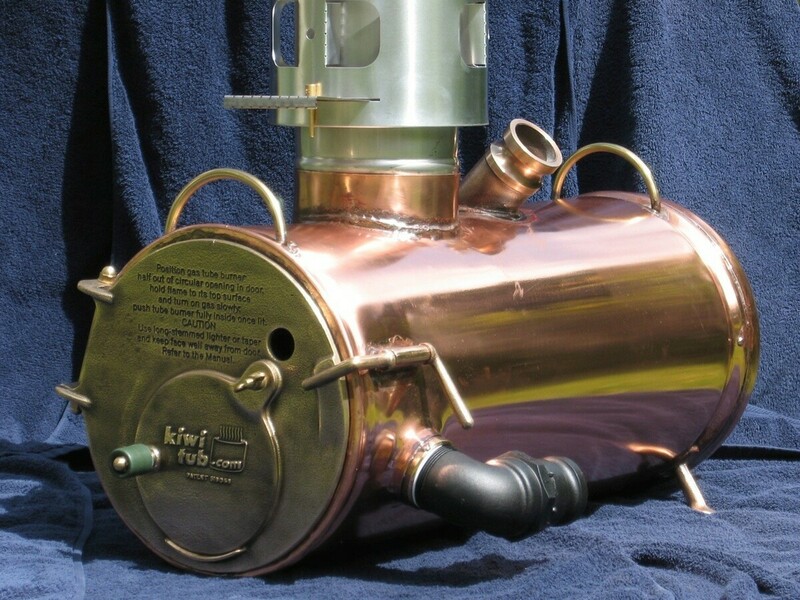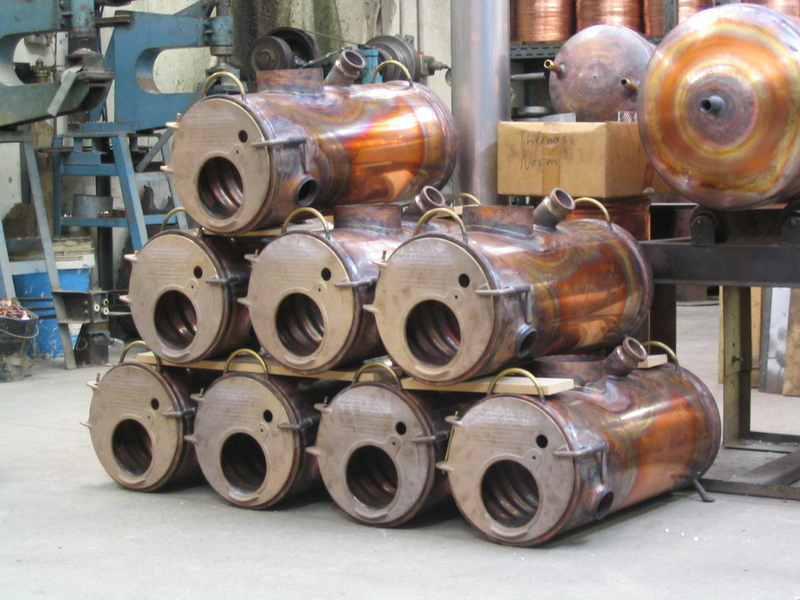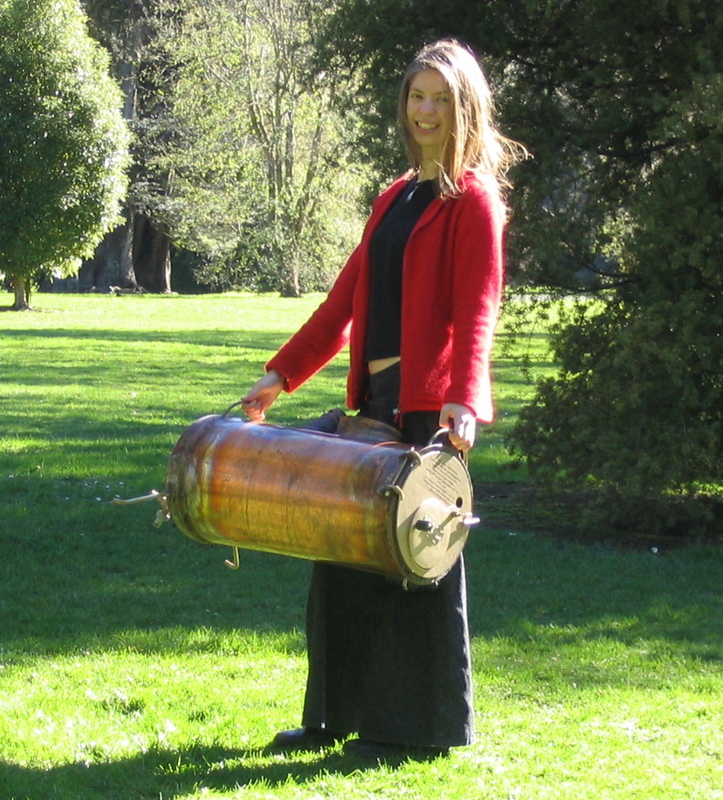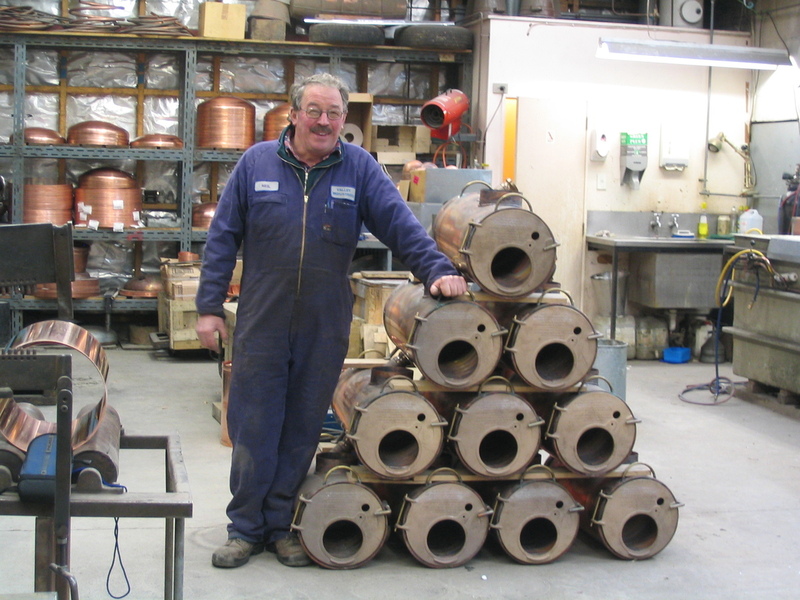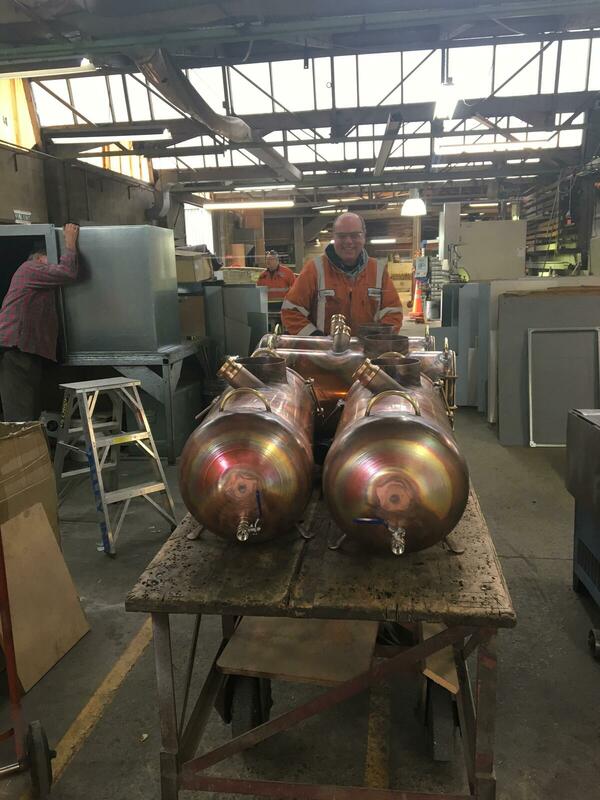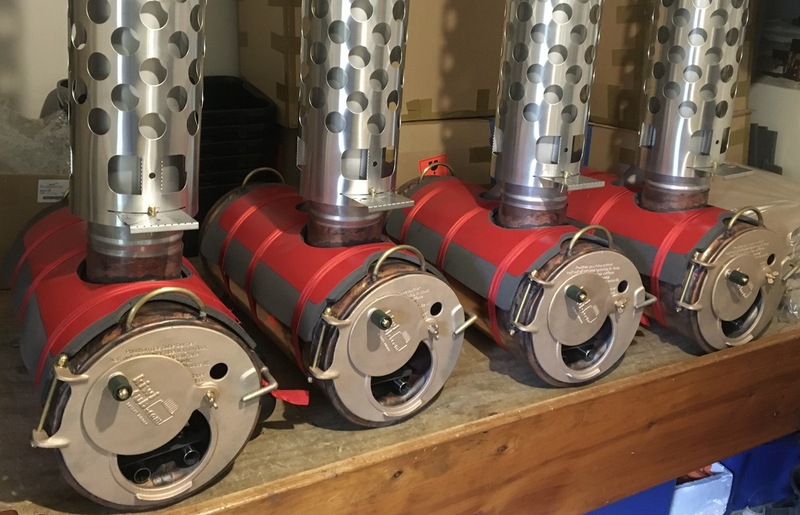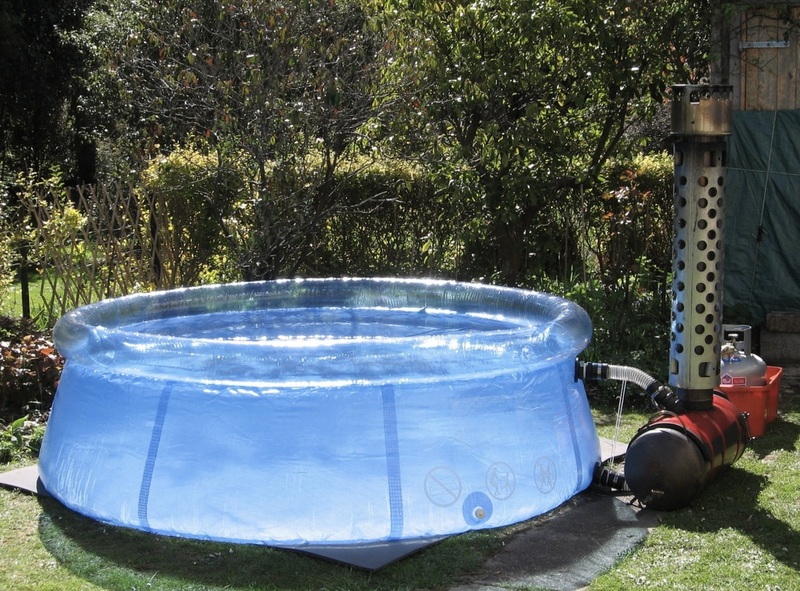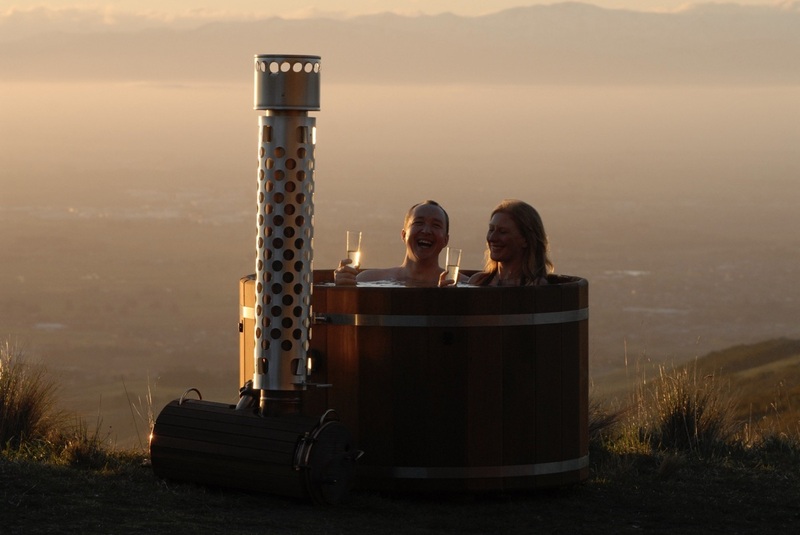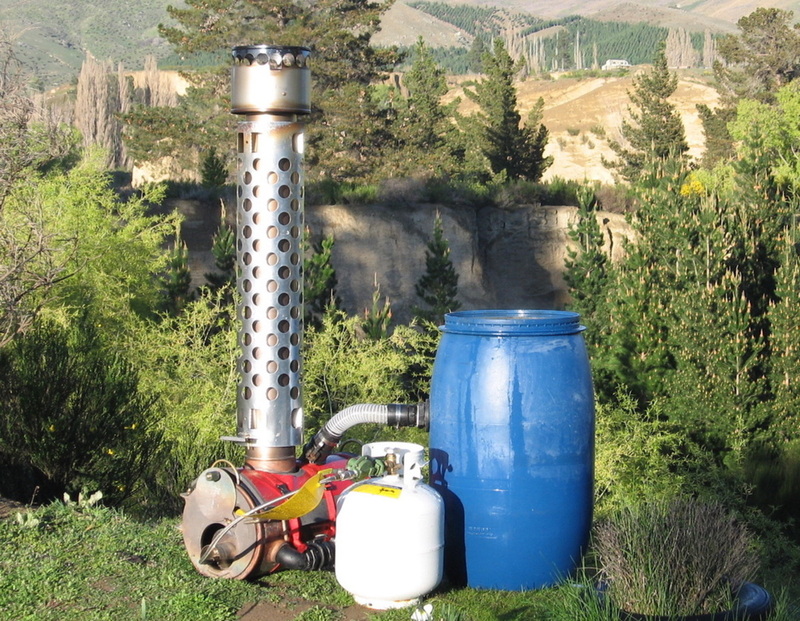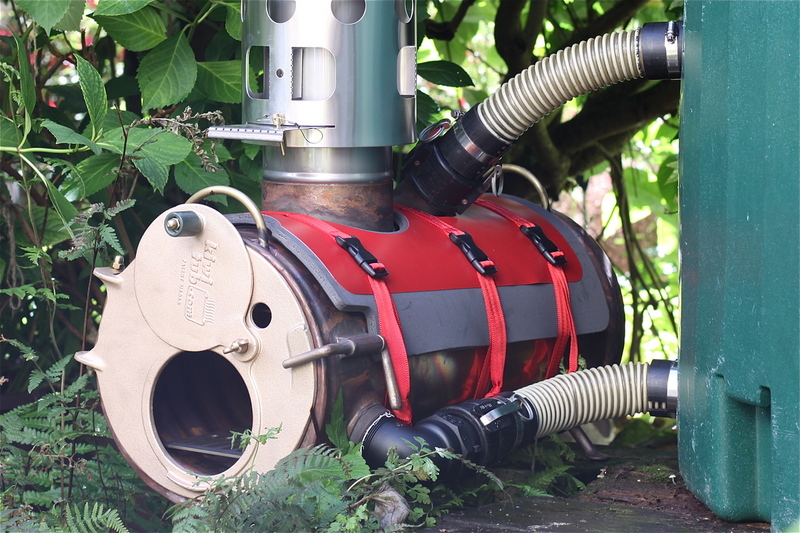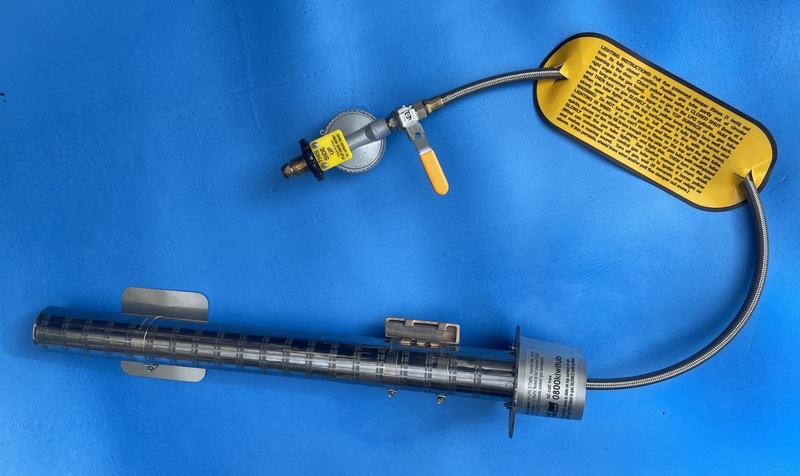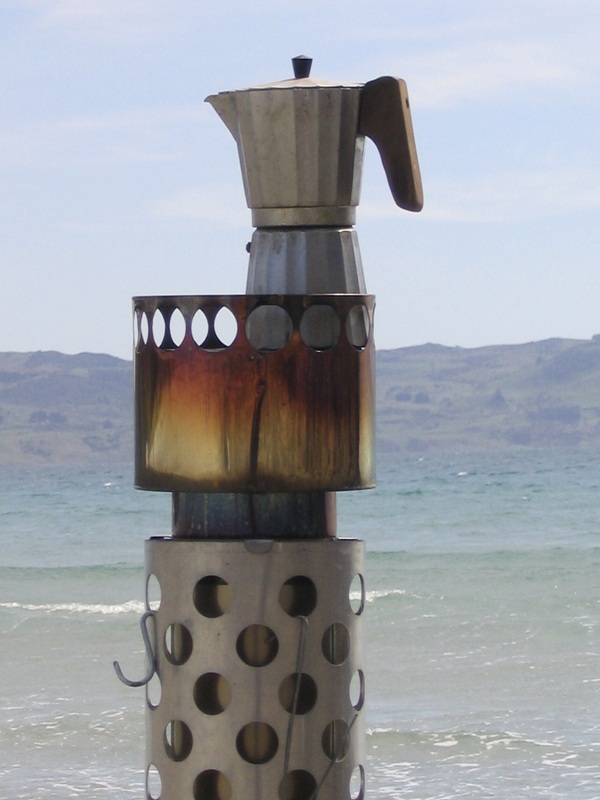The burner
- Hand-crafted brass, copper, and stainless steel.
- It's a multi-fuel burner - runs on firewood, gas, or other solid fuels.
- Heats the tub in (usually) well under two hours.
- You can also make coffee on it.
The Kiwitub burner is essentially two horizontal copper cylinders, one inside the other, with water in between, connected by two hoses to the hot tub. Fire in the central burning chamber heats the water surrounding it, which expands and rises up through the top hose and into the tub. At the same time, cooler water flows in through the bottom hose to replace it.
This circulation continues as long as there is a heat source of any sort in the burning chamber, so the water in the tub steadily gets hotter. It's exactly the same as a wetback on a domestic woodburner heating the hot water cylinder in your home. There are no noisy pumps, motors or electricity needed - the circulation is just driven by the physics.
The Kiwitub burner is basically a giant mutated Thermette, lying on its side, and with extra efficiencies built in. The Thermette is a classic New Zealand invention from the late 1930s - a water heating jug with a fire up its middle. They still make a pot of tea faster than the modern camping gas burners.
The burner is 330mm (13") in diameter and 730mm (2'5") long, and weighs about 24kg (53lb). So, one person can carry it, though two are better for long distances, using the big brass lifting handles at each end.
The inner copper cylinder forming the firebox is corrugated, which gives huge strength and a greater surface area for heat exchange. A stainless steel baffle spreads the flames onto the walls of the burning chamber and creates a longer flame path to heat the water.
The burner comes with a 15mm thick neoprene, closed-cell foam and red PVC insulating jacket. The wrap-around jacket cuts heat loss from the outer skin in cold, wet, windy, or snowy conditions.
The burner is made out of copper for a reason.
Copper transfers heat a staggering 25 times better than stainless steel. That's why good stainless steel saucepans have copper bottoms. If you want to pull heat from the flames and through the metal wall into the surrounding water really well, then copper is what you use. Plus it'll resist seawater corrosion and handle expansion and contraction due to heat pretty much forever - unlike stainless.
The burner sits on its belly, with the two little brass legs at the back ensuring it is stable on all surfaces, like a three-legged stool. The 6mm thick door, carrying handles and legs are cast in brass.
Running the burner on firewood.
Just place in the stainless steel fire grate and build a wood fire on it. The grate has two laser-cut perforated stainless steel tubes mounted underneath. These act as a big secondary air intake - they suck in fresh fully-oxygenated outside air and spill it under the fire.
This turbocharges the performance - we can get the entire flue red hot, which is 1,040˚C for stainless steel. That's why the flue has its perforated aluminium safety guard. When you're running the burner well on good dry firewood there is almost no smoke coming out the flue; just rising hot air. Like an outdoor barbecue, it is acceptable under clean air regulations in New Zealand except for some specific central urban areas, notably the centres of Alexandra and Christchurch. Check with your local authority. Gas is acceptable in all areas.
We've checked out the burner with Fire & Emergency NZ. It does have a stainless steel mesh ash guard built into the cowl; however these are never perfectly safe. FENZ say it avoids all sorts of house regulations because it's a portable unit, and with water completely surrounding the firebox except for the door, it's okay to be used during a total fire ban. Even so, regardless of the regulations, if there's any risk at all, we strongly recommend simply running the burner on gas.
Running the burner on gas.
Just lift the grate out, place the Italian stainless steel LPG tube burner inside the main burner and light that instead. The gas burner output is rated at 36kW/hr which is a LOT. (A big plug-in electric heater in your house would put out about 3kW/hr of heat - ours is more than 10 times that, which is why we can heat a lot of water fast.) You use a 9kg LPG gas bottle to run the gas burner - just like a portable gas barbecue or ring burner.
The Kiwitub is designed for outside use under adult supervision and with manual control. There is no automatic temperature cutoff. We considered these, but they're fragile, temperamental and won't last. When the water in the tub is hot enough, simply turn off the gas (and leave it off - the tub will stay bathing hot for hours). If you're using firewood, the fire can take up to half an hour to die down, so stop feeding it before the tub gets hot enough. It doesn't take much practice to estimate this correctly.
CURRENTLY UNAVAILABLE: The gas tube burner is currently unavailable. The gas burner apparently needs to be re-tested and re-certified, although we've also had expert opinions that our original testing and approval still holds. We're trying to do it right, but it's slow and tortuous. So we can't sell the gas unit until it's sorted - hopefully by mid-2024. Not including it drops the price of the standard full Kiwitub package to $7,300, and the price of the standard burner package to $3,500. If you send us your contact details we can let you know when they are available again.
Running the burner on other fuels.
Any heat source in the burner will heat the tub water. This does raise the interesting possibility of using methylated spirits, kerosene, diesel, fuel oil, etc. but any experimenting is entirely at your own risk. Do let us know how it goes. One potential buyer in Tibet was proposing to use dried yak dung.
There's a safety buffer built into the physics.
Due to thermal gradient, the closer the water gets to hot steaming 40˚C bath temperature, the more the speed of heating slows down. So (on gas), starting with 5˚C mid-winter Dunedin water it'll take about 30 minutes to get to 30˚C, then another 30 minutes to get to 36˚C, then another 30 minutes to get to 40˚C. So the water won't suddenly get blazingly hot.
Serious longevity.
We think the copper and brass main burner should last for 200 years. This is not hype. There are no moving parts like pumps or motors to go wrong or wear out. About 75% of the heat from the burning chamber is transferred to the water surrounding it and circulated away into the tub. This means the burner itself just doesn't get all that hot. So it won't eventually burn through like a cast-iron potbelly stove, which is designed to radiate into the room. By contrast, the Kiwitub burner is a dedicated water heater.
My Dad's old Thermette was the inspiration for the Kiwitub burner design. Dad's one is now over 80 years old and still going strong. Our burner is a development from the same basic design and a lot tougher - we think it'll last a LOT longer than that.
Copper lasts. There are 400 year-old church roofs in Europe made of copper. In 1795 the old 'Endeavour' (not Captain Cook's one; surprisingly there's another) was scuttled in Dusky Sound in Fiordland, after damage in a storm while supplying sealers and whalers. When you dive to it, the wood crumbles to the touch, but the copper nails and sheathing are fine. We think the Kiwitub burner will do as well, but only time will tell.
Other uses for the burner.
We designed it for our hot tub, but you can use the Kiwitub burner to heat other tubs, tanks and water containers. We sell the burner on its own for this, with the hoses and fittings needed. It's a very simple DIY job; instructions are in the Kiwitub manual. All you need do is drill two holes, screw in and hand tighten the standard 50mm plumbing plastic tank fittings, then push and clamp the Kiwitub hoses onto them. We've got all the fittings and hose required.
The burner has been connected to old spa pool shells, a kauri beer vat, cedar hot tubs, cast iron claw-foot baths, an inflatable paddling pool, small plastic tanks to mix milk powder with warm water for calf rearing, various plastic tanks, and those blue plastic barrels common on farms. A 150L barrel heats to hot steaming washing water in about 10 minutes on gas - ideal for camping and outdoor catering. (A bucket with holes in the bottom slung from a tree gives a six minute shower - just fill with a bucket of hot water from the barrel.)
The figures stack up extremely well for using the burner as a swimming pool heater. Place the burner beside the pool, connect the pool hose to the burner inlet with another hose from the burner outlet spilling back into the pool. The water picks up heat as it runs through the lit burner and back into the pool. We're still waiting for feedback on this but it looks like you could boost a swimming pool to extend the season maybe a couple of months either side of summer for the cost of a few 9kg bottles of gas.
The gas tube burner itself makes a brilliant barbecue. Just lay stones or bricks alongside it and a sheet of metal on top. Camping shops and The Warehouse sell cast-iron barbecue plates for about $25. It's a great extra if you're camping with the tub anyway. You do need to throttle the burner right down or it'll crisp anything you put on the plate.
It has also been used under many cast iron claw foot baths.
CURRENTLY UNAVAILABLE: The gas tube burner is currently unavailable, as at April 2024. The gas burner apparently needs to be re-tested and re-certified, although we've also had expert opinions that our original testing and approval still holds. We're trying to do it right, but it's slow and tortuous. So we can't sell the gas unit until it's sorted - hopefully by mid-2024. If you send us your contact details we can let you know when they are available again.
(Photos on this page. The top photo shows the burner commercially polished and lacquered. We provide them clean but not shiny like that. You can do it yourself from the instructions in the manual, or it'll cost about NZ$100 for a commercial polisher to do it. It does turn out stunning! The brass door will still go a bit brown with heat, unfortunately. The sixth and tenth photos down show the brass-fronted production burner wearing its insulation jacket. We've made over 1,600 of this model. We're scared to change it because it's working so well - there are eddy currents and luck involved. Several of the other photos on the website show a different frontage and blue or full red insulation jackets - these are earlier prototype burners.)

